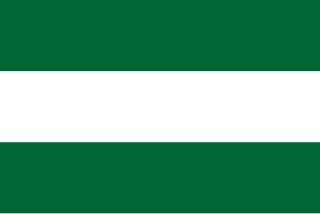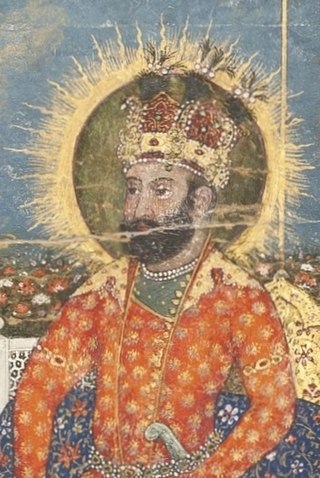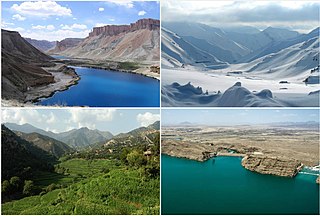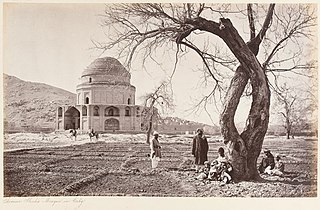
Ahmad Shāh Durrānī, also known as Ahmad Shāh Abdālī, was the first Shah and founder of the Durrani Empire, and is often regarded as the founder of modern Afghanistan.

The Durrani Empire, colloquially known as the Afghan Empire, or the Sadozai Kingdom, was an Afghan empire founded by the Durrani tribe of Pashtuns under Ahmad Shah Durrani in 1747, which spanned parts of Central Asia, the Iranian plateau, and the Indian subcontinent. At its peak, it ruled over present-day Afghanistan, much of Pakistan, parts of northeastern and southeastern Iran, eastern Turkmenistan, and northwestern India. Next to the Ottoman Empire, the Durrani Empire is considered to be among the most significant Islamic empire of the second half of the 18th century.

Kabul is the capital city of Afghanistan. Located in the eastern half of the country, it is also a municipality, forming part of the Kabul Province. The city is divided for administration into 22 municipal districts. In 2025 its population is estimated to be 6.74 million people. In contemporary times, Kabul has served as Afghanistan's political, cultural and economical center. Rapid urbanisation has made it the country's primate city and the 76th-largest city in the world.

The Yusufzai or Yousafzai, also referred to as the Esapzai, or Yusufzai Afghans historically, are one of the largest tribes of Pashtuns. They are natively based in the northern part of Khyber Pakhtunkhwa, to which they migrated from Kabul during the 16th century, but they are also present in parts of Afghanistan, including Kunar, Kabul, Kandahar and Farah. Outside of these countries, they can be found in Ghoriwala District Bannu, Balochistan Sibi (Akazai), Chagai (Hassanzai) and Rohilkandh.

Zaman Shah Durrani, or Zaman Shah Abdali was the third King of the Durrani Empire from 1793 until 1801. An ethnic Pashtun of the Sadozai clan, Zaman Shah was the grandson of Ahmad Shah Durrani and the fifth son of Timur Shah Durrani.

Paghman (Dari/Pashto:پغمان) is a town in the hills near Afghanistan's capital of Kabul. It is the seat of the Paghman District which has a population of about 120,000, mainly Pashtuns and Tajiks. The gardens of Paghman are a major tourist attraction, and the reason for the city being known as the garden capital of Afghanistan. The neighboring town of Qargha is to the southeast, which can be reached by several roads.

Darul Aman Palace is a three-story palace located in Darulaman locality, about 16 km south-west of the center of Kabul, Afghanistan. Surrounding the palace are the following buildings: the National Assembly, the National Museum of Afghanistan and the Afghan International University.
Tajbeg Palace, also inaccurately called the Queen's Palace, is one of the palaces in the popular Darulaman area of Kabul, Afghanistan. The stately mansion is located about 16 kilometres (9.9 mi) south-west from the city's center. It sits on top of a knoll among foothills where the Afghan royal family of the day, known as the Barakzai dynasty, once hunted and picnicked.

Bala Hissar was an ancient fortress located in the south of the old city of Kabul, Afghanistan. The estimated date of construction is around the 5th century AD. Bala Hissar sits to the south of the modern city centre at the tail end of the Kuh-e-Shēr Darwāzah mountain. The Walls of Kabul, which are 20 feet (6.1 m) high and 12 feet (3.7 m) thick, start at the fortress and follow the mountain ridge in a sweeping curve down to the river. It sports a set of gates for access to the fortress. The Kōh-e Shēr Darwāzah mountain is behind the fort. It was destroyed by the British in 1880.

Alakozai is a Pashtun tribe in Afghanistan. They are one of the four tribes of the Zirak tribal confederacy of Durrani Pashtuns.

Bagh-e Babur, also known as Gardens of Babur, is a historic site in Chelsatun, Kabul, Afghanistan. It is located in the Sher Darwaza hillside of District 5, southwest of Shahr-e Naw, or a short distance south of Kabul Zoo and north of Chihil Sutun. The gardens of Babur has several terraced buildings, a small mosque, and plenty of walking space. Visited by up to one million locals and foreign tourists a year, it is also where the tomb of the first Mughal emperor Babur is located. The park is thought to have been developed around 1504, when Babur gave orders for the construction of an "avenue garden" in Kabul, described in some detail in his memoirs, the Baburnama. It has been re-developed by various Afghan rulers since then.

Shahr-e Naw Park, also known as Pārk-e Shahr-e Now, is a general public park in the Shahr-e Naw district of Kabul, Afghanistan. It is one of several original open-space parks planned by Afghan kings during the 19th century. It is being rehabilitated by the Kabul municipality and private entities. Around the park are commercial buildings and small shops.

Kārte Seh, is a neighborhood in western Kabul, Afghanistan, part of District 6. It is a planned and middle-class settlement and is associated with Afghanistan's Shia Hazara minority. Karte Seh is also famous for being the site of the orphanage Aziza is sent to in Khaled Hosseini's novel A Thousand Splendid Suns.

Tourism in Afghanistan is regulated by the Ministry of Information and Culture. There are at least 350 tourism companies operating in Afghanistan. Tourism was at its peak before the 1978 Saur Revolution, which was followed by the decades of warfare. Between 2013 and 2016, Afghan embassies issued between 15,000 and 20,000 tourist visas annually. Following Taliban's return to power in August 2021, visitor numbers gradually increased from 691 in 2021 to 2,300 in 2022, reaching 7,000 in 2023.
Murad Khani or Murad Khane is a small historical neighborhood in Kabul, Afghanistan. The neighborhood is part of the city's District 2, situated north of the Kabul River between Da Afghanistan Bank, Ministry of Defense, Eidgah Mosque, Pul-e Khishti Mosque and Kabul Serena Hotel. The Abul Fazl Shrine is located within this neighborhood.

The Afghan–Sikh wars spanned from 1748 to 1837 in the Indian subcontinent, and saw multiple phases of fighting between the Durrani Empire and the Sikh Empire, mainly in and around Punjab region. The conflict's origins stemmed from the days of the Dal Khalsa, and continued after the Emirate of Kabul succeeded the Durrani Empire.
The following is a timeline of the history of Kabul, Afghanistan.

The tomb of Timur Shah Durrani is located in Kabul and was built in 1815. It is the mausoleum of Timur Shah Durrani, who was the second ruler of the Durrani Empire, from 1772–1793. In 1776 Timur Shah chose Kabul as the capital of Afghanistan, which was Kandahar until then. Although he died in 1793 in Char Bagh, it wasn't until years later that the tomb was built. Timur Shah was later buried in here.

Karte Char, literally Fourth Quarter, is a neighborhood in western Kabul, Afghanistan, part of District 3. It is located by the Sevom Aqrab Road that goes to Kote Sangi, and is located very close to Kabul University, Kabul Zoo, the Gardens of Babur and the Darulaman Road. It is a planned and urbanized locality but it suffered greatly during the 1990s civil war and was one of the city's worst-hit. Karte Seh is located south across the Chamcheh Mast river crossed by Pul-e Surkh.
Fateh Khan Barakzai or Wazir Fateh Khan or simply, Fateh Khan, was Wazir of the Durrani Empire during the reign of Mahmud Shah Durrani until his torture and execution at the hands of Kamran Shah Durrani, the son of the ruler of the Durrani Empire, and Mahmud Shah Durrani, and other prominent conspirators such as Ata Mohammad Khan. Fateh Khan was of the Barakzai tribe, and his death led to his tribe revolting and the eventual deposition of Mahmud Shah Durrani.




















